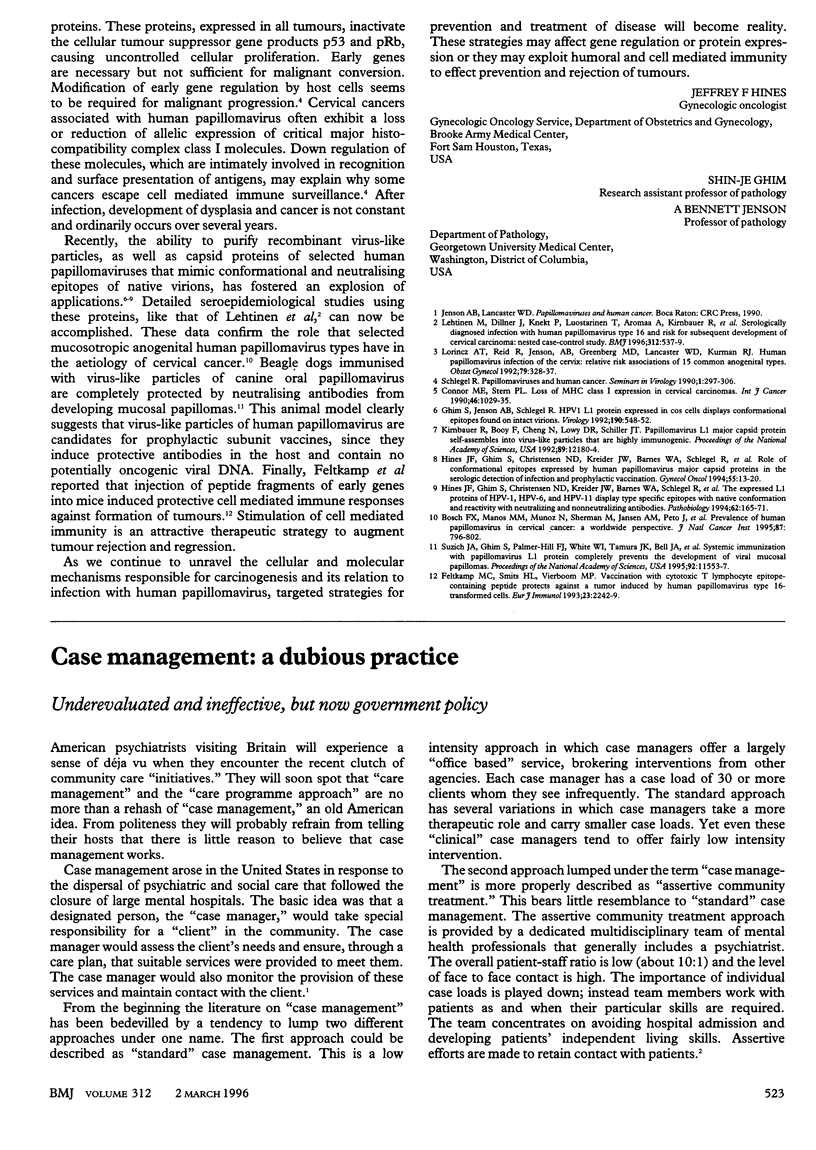Full text
PDF

Selected References
These references are in PubMed. This may not be the complete list of references from this article.
- Bosch F. X., Manos M. M., Muñoz N., Sherman M., Jansen A. M., Peto J., Schiffman M. H., Moreno V., Kurman R., Shah K. V. Prevalence of human papillomavirus in cervical cancer: a worldwide perspective. International biological study on cervical cancer (IBSCC) Study Group. J Natl Cancer Inst. 1995 Jun 7;87(11):796–802. doi: 10.1093/jnci/87.11.796. [DOI] [PubMed] [Google Scholar]
- Connor M. E., Stern P. L. Loss of MHC class-I expression in cervical carcinomas. Int J Cancer. 1990 Dec 15;46(6):1029–1034. doi: 10.1002/ijc.2910460614. [DOI] [PubMed] [Google Scholar]
- Feltkamp M. C., Smits H. L., Vierboom M. P., Minnaar R. P., de Jongh B. M., Drijfhout J. W., ter Schegget J., Melief C. J., Kast W. M. Vaccination with cytotoxic T lymphocyte epitope-containing peptide protects against a tumor induced by human papillomavirus type 16-transformed cells. Eur J Immunol. 1993 Sep;23(9):2242–2249. doi: 10.1002/eji.1830230929. [DOI] [PubMed] [Google Scholar]
- Ghim S. J., Jenson A. B., Schlegel R. HPV-1 L1 protein expressed in cos cells displays conformational epitopes found on intact virions. Virology. 1992 Sep;190(1):548–552. doi: 10.1016/0042-6822(92)91251-o. [DOI] [PubMed] [Google Scholar]
- Hines J. F., Ghim S. J., Christensen N. D., Kreider J. W., Barnes W. A., Schlegel R., Jenson A. B. Role of conformational epitopes expressed by human papillomavirus major capsid proteins in the serologic detection of infection and prophylactic vaccination. Gynecol Oncol. 1994 Oct;55(1):13–20. doi: 10.1006/gyno.1994.1239. [DOI] [PubMed] [Google Scholar]
- Hines J. F., Ghim S. J., Christensen N. D., Kreider J. W., Barnes W. A., Schlegel R., Jenson A. B. The expressed L1 proteins of HPV-1, HPV-6, and HPV-11 display type-specific epitopes with native conformation and reactivity with neutralizing and nonneutralizing antibodies. Pathobiology. 1994;62(4):165–171. doi: 10.1159/000163906. [DOI] [PubMed] [Google Scholar]
- Kirnbauer R., Booy F., Cheng N., Lowy D. R., Schiller J. T. Papillomavirus L1 major capsid protein self-assembles into virus-like particles that are highly immunogenic. Proc Natl Acad Sci U S A. 1992 Dec 15;89(24):12180–12184. doi: 10.1073/pnas.89.24.12180. [DOI] [PMC free article] [PubMed] [Google Scholar]
- Lehtinen M., Dillner J., Knekt P., Luostarinen T., Aromaa A., Kirnbauer R., Koskela P., Paavonen J., Peto R., Schiller J. T. Serologically diagnosed infection with human papillomavirus type 16 and risk for subsequent development of cervical carcinoma: nested case-control study. BMJ. 1996 Mar 2;312(7030):537–539. doi: 10.1136/bmj.312.7030.537. [DOI] [PMC free article] [PubMed] [Google Scholar]
- Lorincz A. T., Reid R., Jenson A. B., Greenberg M. D., Lancaster W., Kurman R. J. Human papillomavirus infection of the cervix: relative risk associations of 15 common anogenital types. Obstet Gynecol. 1992 Mar;79(3):328–337. doi: 10.1097/00006250-199203000-00002. [DOI] [PubMed] [Google Scholar]


